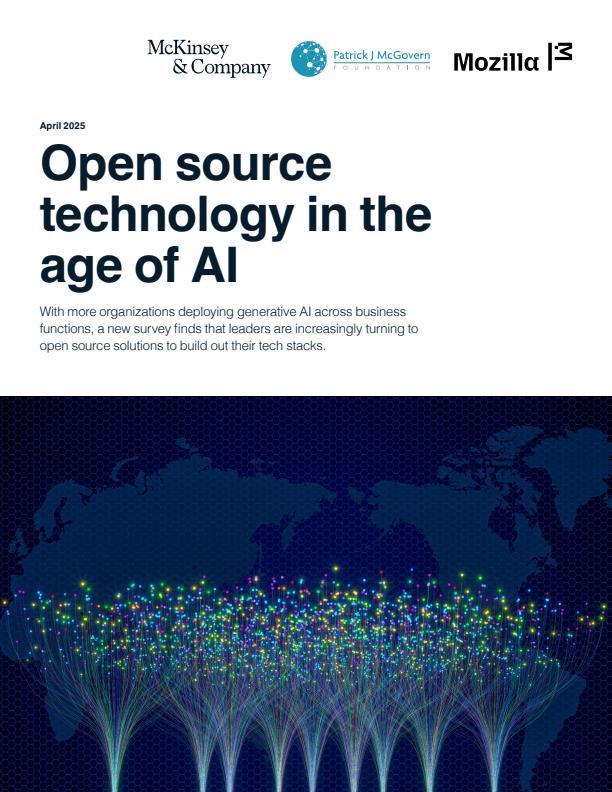This report is part of a research collaboration among McKinsey, the Mozilla Foundation, and the Patrick J. McGovern Foundation.
Open source software has long been a critical part of the technology ecosystem. Commercial software typically requires a commercial license or subscription and restricts access to its core technology. However, open source tools are developed collaboratively and made available to the public to use, modify, and distribute with far fewer restrictions. The open source model gives developers the ability to adapt and shape well-tailored solutions to the particular needs of their organizations.
The current age of AI is no different. As more enterprises build and deploy AI-driven solutions across their businesses, they are turning to a growing array of open source technologies. Such offerings include Meta’s Llama family, Google’s Gemma family, the Allen Institute for Artificial Intelligence’s OLMo family, Nvidia’s NeMo family, DeepSeek-R1, and Alibaba Cloud’s Qwen 2.5-Max—many of which are fast closing the performance gap relative to proprietary AI models.
A new, first-of-its-kind survey of more than 700 technology leaders and senior developers across 41 countries, conducted by McKinsey, the Mozilla Foundation, and the Patrick J. McGovern Foundation, provides the largest and most detailed analysis of how enterprises are thinking about and deploying open source AI in their organizations. The results suggest that leaders are embracing open source tools as essential components of their technology stacks, citing advantages such as high performance, ease of use, and lower implementation and maintenance costs relative to proprietary tools. Developers, meanwhile, increasingly view experience with open source AI as an important part of their overall job satisfaction. While open source solutions come with concerns about security and time to value, more than three-quarters of survey respondents expect to increase their use of open source AI in the years ahead.
Our research shows that enterprises are using open source models more than one might expect. Across several areas of the AI technology stack, over 50 percent of respondents report that their organizations are using open source AI technologies (often alongside proprietary tools from players such as Anthropic, OpenAI, and Google). Organizations that place a high priority on AI are the ones most likely to use open source technologies: Respondents from organizations that view AI as important to their competitive advantage are more than 40 percent more likely to report using open source AI models and tools than respondents from other organizations. The technology industry is leading the way, with 72 percent of respondents’ organizations using an open source AI model, compared with 63 percent of respondents from all organizations.
The survey results provide several key findings:
- Open source AI usage and trends:
- Use of open source AI technologies is widespread. More than 50 percent of respondents report leveraging an open source solution in each of the data, models, and tools areas of the technology stack.
- Technical maturity and developer experience influence open source AI use. Such use is highest in technology, media, and telecommunications (70 percent), and experienced AI developers are 40 percent more likely than peers to use open source AI solutions.
- Organizations are using open source AI tools from familiar players. The most commonly used open source AI tools among enterprises, as of January 2025, are those developed by large technology players, such as Meta with its Llama family and Google with its Gemma family.
- Value to organizations and developers:
- Most respondents are satisfied with their open source AI models. The top reasons for satisfaction reported are performance and ease of use.
- Open source AI tools lead on cost benefits, while proprietary AI tools have faster time to value. Respondents say that open source AI has lower implementation costs (60 percent) and lower maintenance costs (46 percent). But respondents see faster time to value from proprietary AI tools (48 percent).
- Developers value open source AI tools. Most developers (81 percent) report that experience with open source AI tools is highly valued in their field and that working with such tools is important to their job satisfaction (66 percent).
- Future outlook on open source AI: Organizations are open to a mixture of open and proprietary AI solutions. Nearly three-quarters of respondents (over 70 percent) say that they are open to either open source or proprietary AI technologies across areas of the technology stack.
- Risks and mitigation strategies:
- Open source AI tools involve potential challenges. Respondents cite concerns about cybersecurity (62 percent), regulatory compliance (54 percent), and intellectual property infringement (50 percent) when engaging with AI tools.
- Organizations are implementing safeguards to manage risks associated with open source AI tools. Strategies include strengthening information security frameworks and software supply chain controls, using third-party evaluation of models, and implementing guardrails to limit model behavior.
Overall, more than three-quarters of respondents—76 percent—expect their organizations to increase use of open source AI technologies over the next several years. This may be in part because open source tools have served as a part of a vibrant software ecosystem in many categories of enterprise software, as well as a foundational resource for developer communities, for decades. As AI continues to improve, business and technology leaders should pay close attention to all the opportunities and innovations that emerge. Much like in the cloud and software industries, a multimodel approach will likely be prevalent for many companies, with open source and proprietary technologies coexisting in multiple areas of the AI technology stack.
For the full set of data and insights, download the report here.



